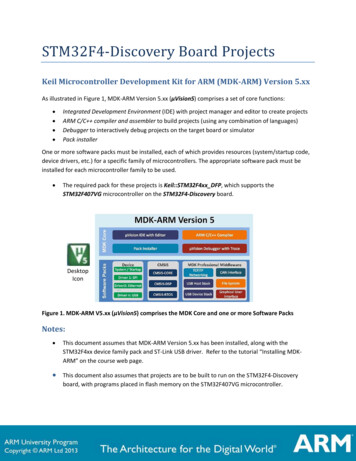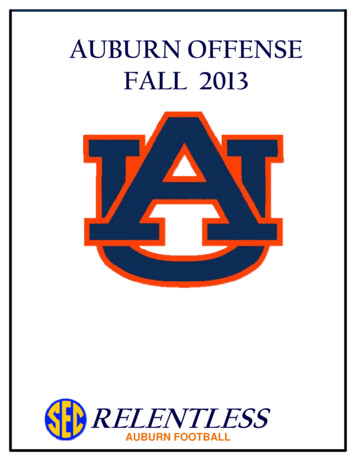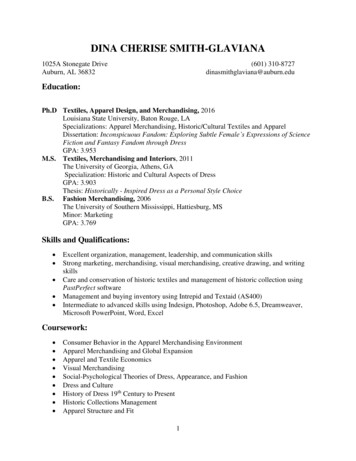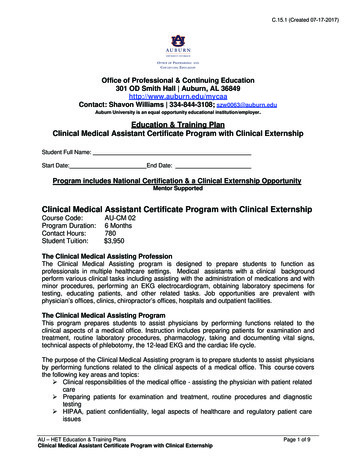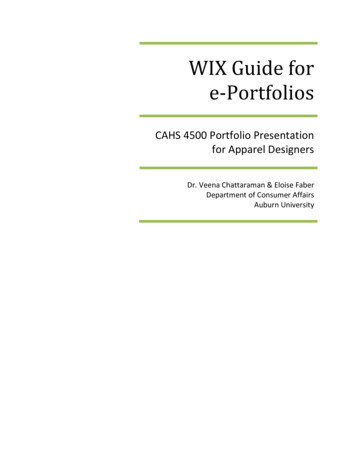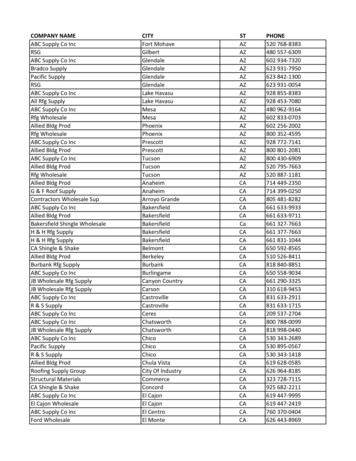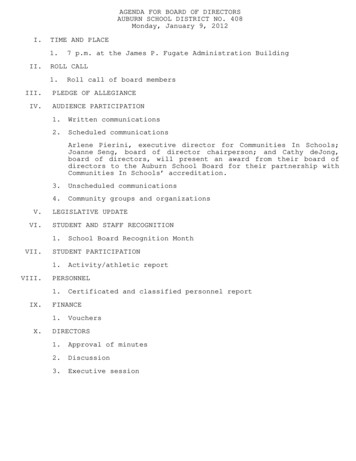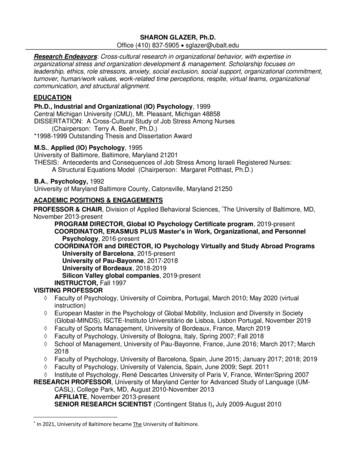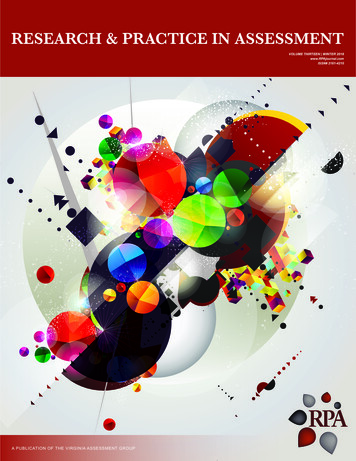
Transcription
RESEARCH & PRACTICE IN ASSESSMENTVOLUME THIRTEEN WINTER 2018www.RPAjournal.comISSN# 2161-4210A PUBLICATION OF THE VIRGINIA ASSESSMENT GROUP
Editorial StaffEditorial BoardEditorSenior Associate Editoranthony lising antonioDaryl G. SmithKatie BusbyRobin D. AndersonStanford UniversityClaremont Graduate UniversityUniversity of MississippiJames Madison UniversityAssociate EditorAssociate EditorSusan BosworthLinda SuskieMegan ShafferLauren GermainCollege of William & MaryIndependent AssessmentConsultantSUNY Upstate Medical UniversityAssessment & AccreditationConsultantEditoral AssistantJennifer A. LindholmJohn T. WillseSarah AndertUniversity of California,Los AngelesUniversity of North Carolinaat GreensboroTulane UniversityEx–Officio MembersVirginia Assessment GroupPresidentPast EditorsVirginia Assessment GroupPresident–ElectRobin D. AndersonKeston H. Fulcher20062007-2010Stephanie FosterRyan OttoJoshua Travis BrownGeorge Mason UniversityRoanoke College2010-2014Review BoardRobert AaronMarc E. GillespieNatasha JankowskiWilliam P. SkorupskiNorthwestern UniversitySt. John’s UniversityNILOAACTAmee AdkinsMolly GoldwasserKimberly A. KlinePamela SteinkeIllinois State UniversityDuke UniversityBuffalo State CollegeUniversity of St. FrancisChris ColemanSarah GordonKathryne Drezek McConnellMatthew S. SwainUniversity of AlabamaArkansas Tech UniversityAssociation of AmericanColleges & UniversitiesHumRRODorothy C. DoolittleChad GotchSean A. McKitrickWendy G. TroxelChristopher Newport UniversityWashington State UniversityMiddle States CommissionKansas State UniversitySeth Matthew FishmanMichele J. HansenJohn V. MooreCatherine WehlburgVillanova UniversityIUPUICommunity Collegeof PhiladelphiaTexas Christian UniversityTeresa FlatebyDebra S. HarmeningIngrid NovodvorskyCraig S. WellsGeorgia Southern UniversityUniversity of ToledoUniversity of ArizonaUniversity of Massachusetts,AmherstMatthew FullerGhazala HashmiLoraine PhillipsThomas W. ZaneSam Houston State UniversityJ. Sargeant ReynoldsCommunity CollegeUniversity of Texas at ArlingtonSalt Lake Community CollegeMegan Moore GardnerS. Jeanne HorstSuzanne L. PieperCarrie L. ZelnaUniversity of AkronJames Madison UniversityNorthern Arizona UniversityNorth Carolina State UniversityKaren GentemannGeorge Mason University2Volume Thirteen Winter 2018
TABLE OF CONTENTS42019 VIRGINIA ASSESSMENTGROUP ANNUAL CONFERENCEWednesday, November 13th – Friday, November 15thDelta Hotel Marriott Richmond, VirginiaFROM THE EDITORFinishing Strong- Katie Busby5Letter to Readers- Keston H. Fulcher6ARTICLESBringing Together Assessment and LearningImprovement: Dreaming Big for an Inaugural Summit- S. Jeanne Horst and Allison J. Ames11For more information visit www.virginiaassessmentgroup.comThe More Things Change, the More They Stay theSame: New Challenges to Using Evidence to ImproveStudent Learning- Charles Blaich and Kathleen Wise15Why Assessment and Faculty Development NeedEach Other: Notes on Using Evidence to ImproveStudent Learning- Michael Reder and Cynthia CrimminsCALL FOR PAPERSResearch & Practice in Assessment is currently soliciting articles andreviews for its Summer 2019 issue. Manuscripts submitted to RPA may berelated to various higher education assessment themes, and should adopteither an assessment measurement or an assessment policy/foundationsframework. Contributions are accepted at any time, but submissionsreceived by March 1 will receive consideration for the summer issue.Manuscripts must comply with the RPA Submission Guidelines and besent electronically to: editor@rpajournal.com20Considerations and Resources for the LearningImprovement Facilitator- Kristen L. Smith, Megan R. Good &Natasha Jankowski27RESEARCH & PRACTICE IN ASSESSMENTThe goal of Research & Practice in Assessment is to serve the assessmentcommunity as an online journal focusing on higher education assessment.It is dedicated to the advancement of scholarly discussion amongstresearchers and practitioners in this evolving field. The journal originatedfrom the Board of the Virginia Assessment Group, one of the oldestcontinuing professional higher education assessment organizations inthe United States. Research & Practice in Assessment is a peer-reviewedpublication that uses a double-blind review process. Approximately fortypercent of submissions are accepted for issues that are published twiceannually. Research & Practice in Assessment is listed in Cabell’s Directoryand indexed by EBSCO, ERIC, Gale, and ProQuest.Refining an Approach to Assessment forLearning Improvement- Monica Stitt-Bergh, Jillian Kinzie& Keston Fulcher34Example of a Program-Level LearningImprovement Report- Diane Lending, Keston Fulcher, Jeremy D. EzellJeffrey L. May & Thomas W. DillonPublished by:VIRGINIA ASSESSMENT GROUP www.virginiaassessment.orgPublication Design by Patrice Brown Copyright 2018Volume Thirteen Winter 20183
RESEARCH & PRACTICE IN ASSESSMENTFROM THE EDITORFinishing Strong“Finish strong” is an acclamation shared by many distance runners, and likelyathletes of any sport. The words encourage the individual to complete the race (or competitionor game) with tenacity and vitality. This special issue of Research & Practice in Assessmentaffords me a strong finish as I conclude my tenure as RPA editor.Research & Practice in Assessment would not exist without the dedication, effort,and expertise, of many volunteers. In particular I would like to take this opportunity to thankthe Editorial Staff members for their tireless efforts in producing each issue and promotingthe journal to assessment and higher education professionals around the world. My sincereappreciation extends to the RPA Review Board members who share their expertise and talent toadvance the scholarship of assessment and the RPA Editorial Board who provide direction andsupport for the journal. RPA is made possible through the support of the Virginia AssessmentGroup and I would also like to thank the VAG Executive Board members with whom I have hadthe pleasure of serving.I am delighted to present this special issue of Research & Practice in Assessmentdedicated to learning improvement. The invited articles in this issue, under the leadershipof guest editor, Keston Fulcher, represent a commitment of thought, action, and reflectionto improve student learning. I welcome Keston Fulcher, Executive Director of the Center forAssessment and Research Studies at James Madison University and former RPA editor, who willintroduce this special issue.Regards,University of Mississippi4Volume Thirteen Winter 2018
RESEARCH & PRACTICE IN ASSESSMENTLETTER TO READERSIn April 2017, James Madison University and the Center of Inquiry at Wabash Collegehosted higher education experts in Washington D. C. The Summit’s purpose was to exploreassessment’s role in learning improvement. At the outset, we endeavored to provide resourcesfor the higher education community including videos and manuscripts. With respect tomanuscripts, RPA editor Katie Busby graciously partnered with us to produce this special issueon learning improvement.In the first article Jeanne Horst and Allison Ames provide more context regarding theneed for the summit, the summit events, emerging themes, and lessons learned. In the nextarticle Charlie Blaich and Kathy Wise provide a different type of overview. They re-visit thequestion: Why so much data collection and so little use in higher education?The next articles provide ideas and tools to promote learning improvement. CynthiaCrimmins and Michael Reder speak to why assessment professionals should work with facultydevelopers. Kristen Smith, Megan Good, and Natasha Jankowski introduce and describe anew type of higher education position: a learning improvement facilitator. Monica Stitt-Bergh,Jillian Kinzie, and I argue that higher education is accustomed to telling learning stories thatemphasize assessment. We suggest a different narrative: a learning improvement story.Finally, Diane Lending, Jeremy Ezell, Jeff May, Tom Dillon, and I share a real-lifeexample of a high-quality learning improvement report. The piece illustrates how an educationalteam partnered to create a much more effective learning environment. As a result, students’interview skills improved dramatically (three standard deviations) from one year to the next.As a concluding note, I hope this issue broadens readers’ conceptualizations ofassessment and improvement. I encourage readers to think more broadly than just assessment.As Megan Good once said, “Assessment is not the answer to the lack-of-learning-improvementproblem.” Let’s start thinking about learning systems and how teams of professionals – faculty,educational developers, administrators, and assessment practitioners - can navigate andimprove them.Regards,Keston H. FulcherJames Madison UniversityVolume Thirteen Winter 20185
RESEARCH & PRACTICE IN ASSESSMENTAbstractIn April 2017, a three-day Learning Improvement Summit, held inWashington, DC, brought together a broad array of national andinternational assessment stakeholders. The purpose of the summitwas to empower a diverse group of faculty and assessment leadersto develop, refine, discuss, and address evidence-based learningimprovement initiatives within higher education. In this short note,we provide a brief discussion of the need for the summit, the summitevents, emerging themes, and lessons learned.AUTHORSS. Jeanne Horst, Ph.D.James Madison UniversityAllison J. Ames, Ph.D.University of ArkansasBringing Together Assessment andLearning Improvement: Dreaming Big for anInaugural SummitIn order for assessment to be a fruitful endeavor, institutions of higher educationneed to move beyond simply meeting accountability demands to emphasizing studentlearning as the goal. This is the vision in which the inaugural summit on assessment’s rolein learning improvement was situated. Over the past few decades, universities have beenasked to show the worth of their programs, in part for accountability reasons. One approachis through assessment, with an oft-cited definition: the ongoing process of establishing clear, measurable outcomes of studentlearning; ensuring that students have sufficient opportunities to achievethose outcomes; systematically gathering, analyzing, and interpretingevidence to determine how well student learning matches our expectations;using the resulting information to understand and improve student learning.(Suskie, 2009, p. 4)CORRESPONDENCEEmailhorstsj@jmu.edu6Volume Thirteen Winter 2018Suskie’s definition closes with the charge to use assessment results to “understandand improve student learning.” Nationally, college and university stakeholders are discussingwhat leaders in the field have deemed most important to the practice of assessment: improvingstudent learning. A recent Chronicle of Higher Education commentary incited discussionamong assessment professionals, claiming “First, it’s clear that people in the assessmentworld have known for some time that their work was not producing results.” (Gilbert, 2018,para. 6). The comments captured the view of those who question the value of assessmentpractices, who desire to assuage faculty members’ resistance toward assessment, and whoblame assessment’s shortcomings on poor methodology. A flurry of responses from theassessment community included letters to the editor, asserting “ assessment offers facultya process to understand what is happening with teaching and learning in our programs andopens a space for conversation about how to improve the learning environment” (Stitt-Bergh,
RESEARCH & PRACTICE IN ASSESSMENTMerrill, & Foster, 2018, para. 4). The difference between Gilbert (2018) and the response byStitt-Bergh, Merrill, and Foster (2018) could not be more striking. Clearly, it is time to refocusassessment conversations to emphasize student learning.Need for Focused Discussion on Learning ImprovementThe assessment cycle followed by many universities typically includes a stage suchas “use of results for improvement,” often referred to as “closing the loop” (see an example es/saac/assessment-cycle.shtml). However, itis at this point in the assessment cycle where programs often lose momentum, continuity, anddirection (Blaich & Wise, 2011; Bresciani, Gardner, & Hickmott, 2009; Smith, Good, Sanchez,& Fulcher, 2015). Consequently, and despite the pervasiveness of assessment programsacross the higher education landscape, there are relatively few evidence-based examples thatpublicly document use of assessment results to improve student learning at the academicprogram level (Baker, Jankowski, Provezis & Kinzie, 2012; Banta & Blaich, 2011; Blaich &Wise, 2011; Fulcher, Good, Coleman, & Smith, 2014). In fact, a systematic study evaluating146 assessment programs identified that only six percent of the programs evaluated showedevidence of student learning (Banta, Jones, & Black, 2009).Despite the limited evidence, it is important to emphasize that we do believe thatstudent learning is happening. Moreover, we firmly believe that faculty members want theirstudents to learn. What is not happening, however, is widespread improvement of studentlearning at the academic degree program or institutional levels that is directly connected toassessment results. One way in which the field of assessment can move forward is to make aconcerted effort toward understanding and defining what it means to use assessment resultsto improve student learning.In order for assessmentto be a fruitful endeavor,institutions of highereducation need to movebeyond simply meetingaccountability demandsto emphasizing studentlearning as the goal. Thisis the vision in whichthe inaugural summiton assessment’s role inlearning improvementwas situated.During the 2015-2016 academic year, we began wondering whether, where, and withwhom there were conversations happening that involved assessment and improved studentlearning. As a result, the need for intentional, focused conversation among a broad arrayof national stakeholders was identified. The idea for a learning improvement summit wassolidified by the observation that, at the time of planning, it was rare for higher educationconferences to include presentations focused upon learning improvement. At that time, evenwithin assessment conferences, only a very small portion of the presentations were dedicatedto assessment’s role in improvement. For instance, the 2015 Assessment Institute (IndianaUniversity–Purdue University Indianapolis, 2015) included only one presentation on learningimprovement, representing 1% of the total presentations1. Similarly, the Association for theAssessment of Learning in Higher Education conference (2015) had only five (approximately8% of the total) presentations with a focus on student learning. The American EducationalResearch Association’s 2015 proceedings returned over 500 presentations when “assessment”was searched but only three of those (less than 1% of the total) also contained “learningimprovement.” The lack of coverage at national assessment conferences clearly calledfor a focused discussion on improved student learning. This led to the inaugural LearningImprovement Summit in Washington, DC in April 2017.Learning Improvement SummitThe purpose of the three-day Learning Improvement Summit was to provide a spacefor conversation specifically focused on use of assessment results in the learning improvementprocess. Through collaboration between faculty at James Madison University and the Centerof Inquiry at Wabash College directors, participants who represent the broad spectrum ofthe higher education landscape were invited to attend. The number of participants includedin the inaugural summit was limited due to venue space and the desire to create a spacethat would promote focused conversation and collaboration. We intentionally includedvoices representative of a diverse array of stakeholders, including those of higher educationpractitioners, pioneers in the field of assessment, accrediting agencies, testing companies,1The dream is spreading. A learning improvement track was included in the 2018 conference.Volume Thirteen Winter 20187
RESEARCH & PRACTICE IN ASSESSMENTnational higher education associations, government agencies, and representatives from oneinternational country. We dreamt big. And, to our delight, the invited participants came andengaged in a spirited discussion.Throughout the three-day summit, participants were tasked with discussing andaddressing issues regarding learning improvement initiatives. The objectives for the summitwere to:1. Empower the higher education community by moving the assessmentneedle beyond meeting accountability demands to emphasizing studentlearning as the goal.2. Develop or refine working definitions of learning improvement thatinclude the role of assessment at the university program level.3. Develop a community of, and dialogue among, higher educationprofessionals focused on assessment’s role in promoting evidence ofstudent learning at the program level.4. Discuss and address issues, such as how to embed learningimprovement efforts into institutional/organizational cultures.5. Strategize about how to most effectively disseminate learningimprovement efforts to the broad higher education community, sothat all can benefit.Keynote speakers and invited presentations laid the groundwork on the first day2.Specifically, Trudy Banta and Peter Ewell discussed Thirty-Five Years of Assessment: Past,Present, and Future. Keston Fulcher and Cara Meixner outlined a learning improvementframework that promotes collaboration between assessment professionals and facultydevelopers – Foundations of Learning Improvement. Charles Blaich and Kathy Wise discusseda realistic view of assessment in Walking the Assessment Beat on the Mean Streets of HigherEducation. Following the keynote addresses were a series of nine invited seven-minutepresentations, illustrating applied examples of learning improvement. The remaining two daysof the summit consisted of working sessions, group discussions, and breakout teams.Emerging Themes and Areas of Future CollaborationDreamsThe lack of coverageat national assessmentconferences clearlycalled for a focuseddiscussion on improvedstudent learning.A variety of themes emerged from the summit. Undergirding the themes was the desirefor continued communication and the need for a shared language surrounding the concept oflearning improvement. Although we felt it important to include a diverse group of stakeholders,doing so necessitated granting participants the opportunity to clearly articulate their ownperspective. As the variety of ideas were laid on the table, it was immediately apparent that wehold diverse perspectives on the definition of learning improvement. We realized that we haddreamt big in regard to the second summit objective to “Develop or refine working definitionsof learning improvement that include the role of assessment at the university program level.”Additional discussion beyond the initial three-day summit would be necessary in order tomeet the objective of a refined definition of learning improvement. Fortunately, the majorityof participants expressed a desire to continue the conversation.Another big theme that emerged: where, or how, does accreditation fit? Certainly,assessment’s role in accreditation and accountability cannot be abandoned. Ewell (2009)reminds us that there can be tension between an institution’s emphases on accountabilityversus student learning. Accreditation demands should partially shape the emerging definitionof learning improvement. Relatedly, the existing infrastructure in higher education shouldbe considered. The learning improvement work must be fully integrated into the life of an28Volume Thirteen Winter 2018Video-tapes of keynote addresses and learning improvement examples may be found 017/LearningSummit.shtm
Texas Christian University Chris Coleman University of Alabama Sarah Gordon Arkansas Tech University . In the first article Jeanne Horst and Allison Ames provide more context regarding the need for the summit, the summit events, emerging themes, and lessons learned. . Allison J. Ames, Ph.D. Univ
